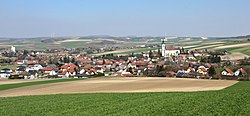Burg Kreuzenstein

Burg Kreuzenstein is a castle near Leobendorf in Lower Austria, Austria. Burg Kreuzenstein is 265 metres (869 ft) above sea level. It was constructed on the remains of a medieval castle that had fallen into disrepair and was then demolished during the Thirty Years' War. Intended to be a family vault for the Wilczek family, it was rebuilt in the 19th century by Count Nepomuk Wilczek with money from the family's large Silesian coal mines. Kreuzenstein is interesting in that it was constructed out of sections of medieval structures purchased by the family from all over Europe to form an authentic-looking castle. Thus, the castle can be considered both a 'neo-' and 'original' medieval structure. The castle is sometimes used as a location for films. This castle is sometimes confused with the medieval castle Burg Liechtenstein, where the movie The Three Musketeers was filmed in 1993. Both castles used the same architect for restoration in the 19th century.
Excerpt from the Wikipedia article Burg Kreuzenstein (License: CC BY-SA 3.0, Authors, Images).Burg Kreuzenstein
Kreuzensteiner Straße, Gemeinde Leobendorf
Geographical coordinates (GPS) Address External links Nearby Places Show on map
Geographical coordinates (GPS)
| Latitude | Longitude |
|---|---|
| N 48.3791666667 ° | E 16.3088888889 ° |
Address
Burg Kreuzenstein (Kreuzenstein Castle)
Kreuzensteiner Straße
2105 Gemeinde Leobendorf
Lower Austria, Austria
Open on Google Maps








